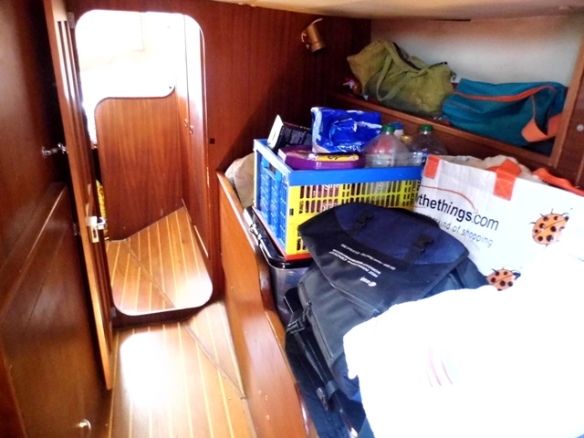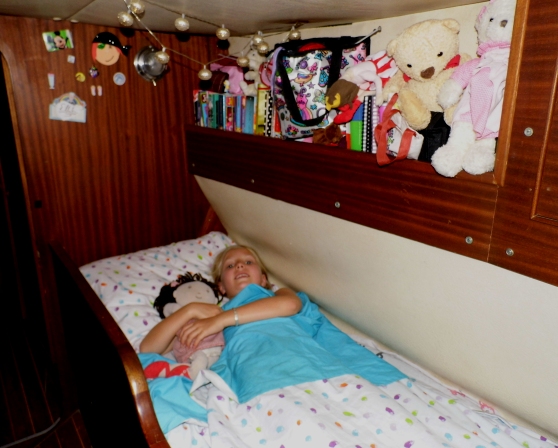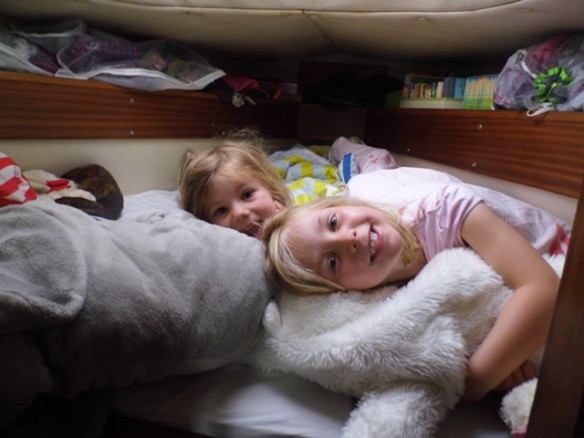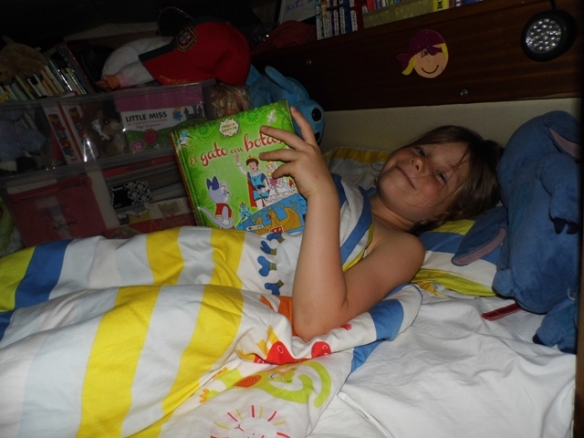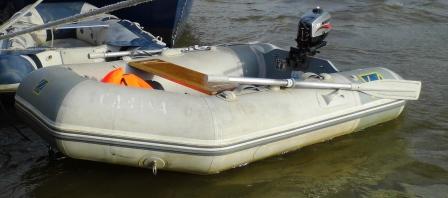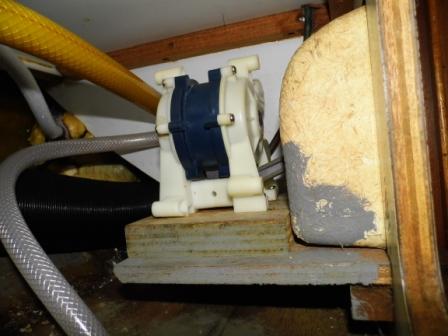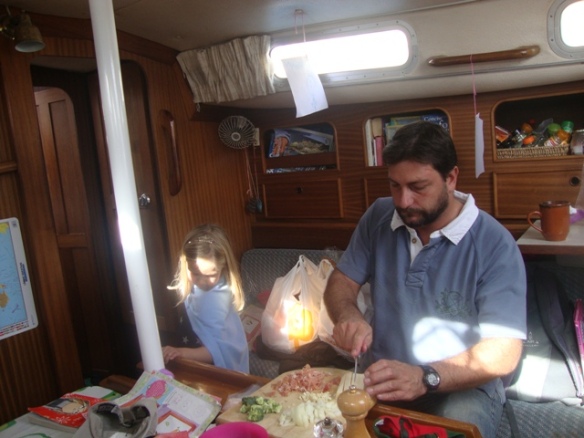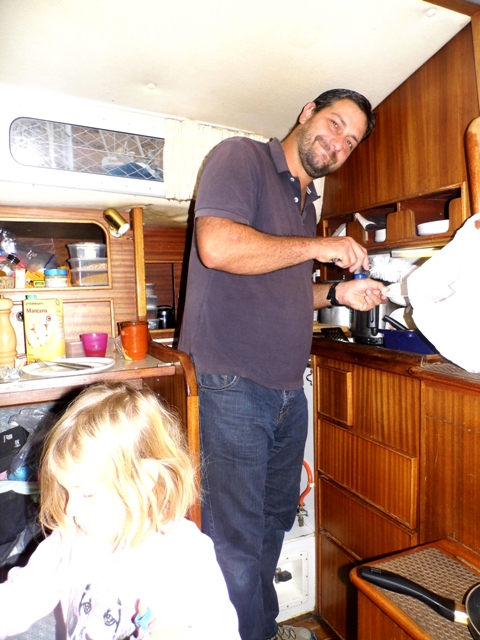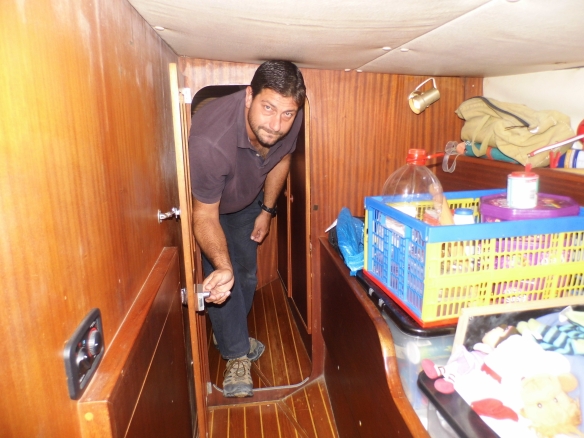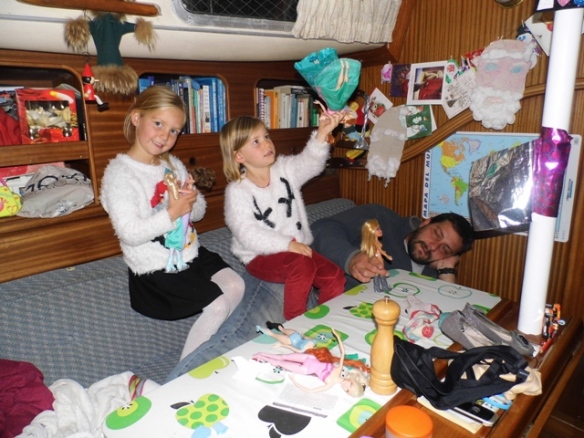Sometimes it all goes pear-shaped. Like this past week. We were minutes away from anchoring at the end of our trip back upriver from Ayamonte when one of the engine alarms went off. At first it was a low whistle and I wasn’t quite sure if it was coming from Carina or from one of the other boats anchored nearby in the river. Julian was on the foredeck, getting ready to drop anchor. I put my ear to the ignition panel in the cockpit and sure enough, the alarm sound was emanating from there. Cupping my hand to block out the light shining on the bank of alarm lights confirmed it was the temperature alarm. The engine was overheating. The sound wasn’t too bad. Not the ear-piercing, heart stopping shrieking of the engine alarm that we had back in August 2013 when we limped into the marina in Brest, in Brittany, and were holed up for four days while Julian semi-solved the problem. I keep my ear to the alarm while Julian lays out the anchor chain.
We have a party to go to and then the Three Kings procession and then another party after that, so now is not the time to try to figure out what’s wrong with the engine. Then we sit at anchor for four nights and there are so many other things to do, the engine takes a back seat.
Friday is the first day of the new school term. Julian takes the girls to and from school in the dinghy. He goes to collect them at the end of the school day and I stay on board to get lunch ready. When I hear the dinghy coming back downriver I go to the stern to help them aboard. They don’t need my help to get aboard, but after a five hour separation I’m too impatient to see them to wait until they come those extra four metres into the saloon!
‘Where are your schoolbags?’ I ask, as Lily climbs aboard. In the excitement of meeting their long lost friends, they have left their schoolbags behind on the pontoon. Julian turns around and zips back upriver to get the bags. We’ve been doing a lot of zooming up and down river these past few days, what with all those parties. And we haven’t put petrol in the outboard for a few days. This latest, unplanned, trip back to Sanlúcar to collect the schoolbags takes more petrol than is currently in the fuel tank and Julian just makes it back to Carina on fumes. (This is no big deal as far as safety goes. He has oars and arms and is on an ebb tide on a calm day so rowing would be no problem). He climbs aboard for lunch and we think no more of the outboard.
We’re only a couple of days off spring tides now and with each ebb Carina is in shallower and shallower water. On Saturday morning we move her a few metres farther into the middle of the river. This manoeuvre takes only a few minutes, but Julian tells me to leave the engine running so he can begin to figure out what caused the alarm to sound when the engine was last running. He does some checks, and after twenty minutes the alarm sounds again.
Later Saturday morning Julian puts new petrol in the outboard so we can all go ashore for a walk and a picnic with some friends. The outboard sputters and splutters, judders and jiggles, and gets us to shore, but only just, with Julian playing around with the throttle and the choke likes he’s Quincy Jones at a music desk. Many hours later, when we return from our picnic, the outboard won’t start at all and I row the four of us home, greatly assisted by the ebb tide.
We’re only aboard five minutes and thinking about what we might have for supper when we hear the sound of a dinghy coming our way. It’s Phil from Naisso. Irlem has made feijoada, the national dish of his native Brazil and he’s been saying for weeks that the next time he makes it he’ll have us around for supper.
Erm, we’d love to come around, I tell Phil, but the outboard’s not working. The four of us will never get the 300 metres upriver to Naisso rowing against a spring tide in full ebb. I put a solution to Phil and he agrees to give it a try, but isn’t sure if his little outboard will be up to it. If the girls and I go with Phil in his dinghy, we can tow Julian behind in our dinghy, with Julian rowing to give what assistance he can to the labours of Phil’s outboard. We’ll still be on an ebb tide by the time we finish dinner and we can float back downriver to Carina.
The girls and I climb in with Phil and I hold the painter of our dinghy. We slowly make our way upriver against the ebb, Phil’s little outboard giving it all she’s got, Julian rowing behind. Our friends on other boats are much amused as they watch our progress. It all goes well, and we reach our destination, but I narrowly avoid falling in the river as I climb aboard Naisso. We have a thoroughly wonderful evening and a dinner so delicious that words fail me. And at 10pm, we drift downriver, Julian dipping an oar in now and again to correct our course towards Carina.
Sunday is to be our ‘day of rest’, when we don’t leave the boat. Julian plans to devote the day to investigating and hopefully solving the problems of both the outboard and inboard engines. He spends the morning working on the outboard, taking it apart, cleaning the filters and carburettor. His first test run with it fails and he has to strip it apart again, but by lunchtime the outboard is working like a dream. At least he won’t have to row against the ebb to get the girls to school in the morning. (If you think we’ve got an extraordinary amount of ebb tide, it’s because we do. Because of the fast flowing river, flood tides here are a little less than five hours in duration and ebbs a little more than seven).
He takes a break for lunch and then plans to launch into the bigger job, Carina’s engine. But when I open the cupboard under the sink where the pots and pans are stored, I discover the bottom of the cupboard is wet. This has happened before, and it’s always simply a loose water pipe to the galley taps. It just requires a little tightening and drying out of the cupboard. I remove all the pots and pans and Julian gets down on his hands and knees in the tight space between the galley and the companionway steps, to fix the problem.
But this time the problem isn’t the pipe. The pipe is as dry as a bone. There must be a leak somewhere else in the system. He removes the floor in front of the sink and cooker to reveal about 20 litres of water sloshing about. He sets about removing the water, a jug full at a time and then tries to figure out where all this water has come from. From its location and the dryness of our deep bilges we know that this water isn’t coming in from outside. We have an internal leak.
His exploration reveals the foot pump to be the source of the leak. You see, we get water into our taps by means of an electrical pump powered by our bank of domestic batteries or by means of a foot pump located near the floor under the cooker. When we are at anchor we use the foot pump, to reduce the energy drain on our batteries, and we only use the electric pump when we are on a pontoon and have mains electricity.
Cutting off the water supply to the foot pump requires some speedy movements to insert a wooden bung before the water spills everywhere. While Julian, like the Dutch boy and the dyke, keeps his finger in the pipe, I rummage around in a cupboard for an appropriately-sized bung. For some reason we are both in a good mood and we find it all pretty comical. Another day we might not have been so light hearted about it all!
With the pipe blocked, Julian takes the foot pump out and painstakingly takes it apart, inspects all the constituent bits, cleans them up and puts it all back together again. Most of the fiddly screws are back in place before he realises he has forgotten to reinsert the spring at the centre of the mechanism. So he has to undo the whole blooming thing and start all over again. He suspects that nothing he has done will have solved the problem and when he puts the pump back in place he is proven right. The pump is broken, perhaps not beyond repair, but to repair it will require the purchase of spare parts online. And the afternoon he has planned to devote to the engine has now been spent on the foot pump.
He spends Monday morning trying to solve the problem of the engine. He gets so far as figuring out that it’s got something to do with the flow of external water through the cooling system. But the exact nature of the problem or how to solve it remains a mystery. He then spends the afternoon online, ordering spare parts for the pump and trying to learn more about the engine cooling system.
At least the laptop is working now, allowing him to do this. A few days after Christmas the laptop died and it took a couple of hours of painstaking work on Julian’s part, taking it apart, cleaning all the bits, putting it back together, rebooting it, before eventually bringing it back to life again.
On Tuesday morning he returns to the engine again. He reads the owner’s manual cover to cover and thinks he may have found a solution to the problem. As I write he is on the bus going to Vila Real to purchase the necessary fluids and parts from the chandlery. We still have a leaking foot pump that can’t be used until the faulty parts arrive by post and are replaced, an engine cooling system that needs to be fixed, and one very frustrated skipper. It never rains but it pours.





